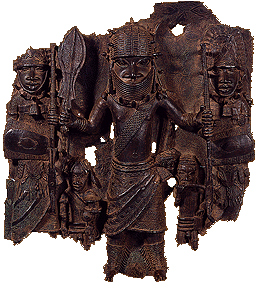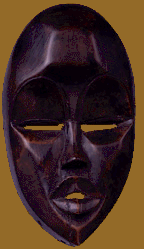
WESTERN AFRICA

WESTERN AFRICA

The peoples of the Atlantic coast of western Africa, from Cameroon to Senegal and as far inland as the Savanna, have developed sophisticated art traditions.
Many languages are spoken in western Africa. The Bantu language probably spread from the Nigeria-Cameroon border over much of Africa south of the Sahara. Ironworking technology probably dispersed from the same area, although its origin may have been farth er north or east.
Mask with Large Spiral Headdress,
Ekoi, Nigeria, Animal skin, wood and natural fibers,
Private Collection

Five Figure Plaque, Benin, 17th century, Bronze, Collection of Sidney and Bernice Clyman
Western Africa is rich in archaeological finds. Metalworking and ceramics appeared in this area about two thousand years ago. Iron tools allowed for efficient clearing of the forest, tilling of the soil, and harvesting of crops, leading to the establishme nt of settled agricultural communities, a prerequisite for major art production.

Maiden Mask, Igbo, Nigeria, Wood, William Hughes Hayden Collection,
Iron also facilitated the carving of sculpture in wood. Clayworking led to efficient storage and cooking vessels and allowed for the development of ceramic statuary.
The ceramic sculptures of the Nok culture of northern Nigeria, dating from about 500 b.c. to a.d. 200, are the earliest known examples of figurative sculpture south of the Sahara. It has been suggested that they were made by women, an idea in part based o n later evidence from Ghana that female Akan potters made that society's heads and figures portraying the royal dead
The practice of casting metal sculpture, in copper alloys of varying composition, appeared at Igbo-Ukwu in eastern Nigeria in the tenth century, in Ife (along with clay sculpture) about two centuries later, and at Benin still later.

Funerary Head, Akan, Ghana, Terracotta, 33 x 19 x 17 cm
The casting of copper alloys continued to flourish at Benin as late as the end of the nineteenth century, ending as a royally sponsored art only with the British Punitive Expedition of 1897, which removed thousands of works that had decorated the king's p alace and the royal ancestral altars.
Many sculptural traditions in wood (a medium that does not survive archaeologically) developed in western Africa. Some were associated with leadership: the royal arts of the Akan of Ghana, the kingdoms and chieftaincies of the grasslands in Cameroon, and the richly diverse artistic traditions of the Yoruba of Nigeria.
Works of art were produced to celebrate chiefly prestige, to decorate shrines, for divination, and to control supernatural forces.

Mask, Dan, Liberia, Wood, Private Collection.
Farther west in this area are found a variety of masks associated with coming-of-age ceremonies and voluntary associations. Most of these are used by men's groups, with the unique exception of the masks and figures produced for women's societies in Sierra Leone and Liberia.
<- Back to the Main Index Page
<- To the Clickable Map of Africa ->
<-To Programs and Events in Conjunction with this Exhibition ->
![]()